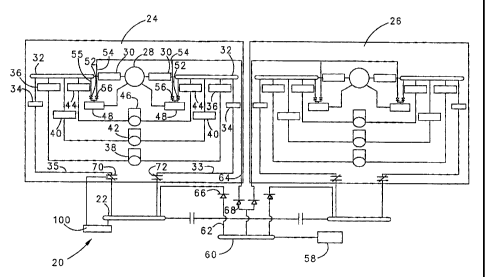Une partie des informations de ce site Web a été fournie par des sources externes. Le gouvernement du Canada n'assume aucune responsabilité concernant la précision, l'actualité ou la fiabilité des informations fournies par les sources externes. Les utilisateurs qui désirent employer cette information devraient consulter directement la source des informations. Le contenu fourni par les sources externes n'est pas assujetti aux exigences sur les langues officielles, la protection des renseignements personnels et l'accessibilité.
L'apparition de différences dans le texte et l'image des Revendications et de l'Abrégé dépend du moment auquel le document est publié. Les textes des Revendications et de l'Abrégé sont affichés :
| (12) Brevet: | (11) CA 2638648 |
|---|---|
| (54) Titre français: | GENERATEUR POUR TURBINE A GAZ COMPORTANT UN CONTROL DE COURT- CIRCUIT DE BARRE OMNIBUS POUR COURANT CONTINU AU MOYEN D'UNE BATTERIE |
| (54) Titre anglais: | GENERATOR FOR GAS TURBINE ENGINE HAVING DC BUS FAULT SHORT CIRCUIT CONTROL USING A BATTERY |
| Statut: | Réputé périmé |
| (51) Classification internationale des brevets (CIB): |
|
|---|---|
| (72) Inventeurs : |
|
| (73) Titulaires : |
|
| (71) Demandeurs : |
|
| (74) Agent: | NORTON ROSE FULBRIGHT CANADA LLP/S.E.N.C.R.L., S.R.L. |
| (74) Co-agent: | |
| (45) Délivré: | 2011-09-27 |
| (22) Date de dépôt: | 2008-08-13 |
| (41) Mise à la disponibilité du public: | 2009-02-16 |
| Requête d'examen: | 2008-08-13 |
| Licence disponible: | S.O. |
| (25) Langue des documents déposés: | Anglais |
| Traité de coopération en matière de brevets (PCT): | Non |
|---|
| (30) Données de priorité de la demande: | ||||||
|---|---|---|---|---|---|---|
|
Un système électrique d'aéronef comprend une génératrice à entraîner comme faisant partie d'un moteur de turbine à gaz. La génératrice fournit de l'énergie électrique à plusieurs accessoires associés au moteur de turbine à gaz, et à une barre omnibus de courant continu pour aéronef en parallèle à la fourniture des accessoires. Une batterie fournit de la tension à un circuit de commande pour le générateur au moyen d'un contact sélectivement ouvert et fermé. Un capteur détecte un court-circuit sur la barre omnibus de courant continu pour aéronef. Le contact de batterie permet à l'énergie de la batterie de s'écouler afin de fournir une tension de commande pour le générateur si le capteur détecte un court-circuit sur la barre omnibus de courant continu pour aéronef.
An aircraft electrical system comprises a generator to be driven as part of a gas turbine engine. The generator supplies electrical power to a plurality of accessories associated with the gas turbine engine, and to an aircraft DC bus in parallel to the supply to the accessories. A battery supplies voltage to a control circuit for the generator through a selectively opened and closed switch. A control detects a short circuit on the aircraft DC bus. The battery switch allows power from the battery to flow to provide control voltage for the generator when the control detects a short circuit on the aircraft DC bus.
Note : Les revendications sont présentées dans la langue officielle dans laquelle elles ont été soumises.
Note : Les descriptions sont présentées dans la langue officielle dans laquelle elles ont été soumises.

Pour une meilleure compréhension de l'état de la demande ou brevet qui figure sur cette page, la rubrique Mise en garde , et les descriptions de Brevet , États administratifs , Taxes périodiques et Historique des paiements devraient être consultées.
| Titre | Date |
|---|---|
| Date de délivrance prévu | 2011-09-27 |
| (22) Dépôt | 2008-08-13 |
| Requête d'examen | 2008-08-13 |
| (41) Mise à la disponibilité du public | 2009-02-16 |
| (45) Délivré | 2011-09-27 |
| Réputé périmé | 2015-08-13 |
Il n'y a pas d'historique d'abandonnement
| Type de taxes | Anniversaire | Échéance | Montant payé | Date payée |
|---|---|---|---|---|
| Requête d'examen | 800,00 $ | 2008-08-13 | ||
| Le dépôt d'une demande de brevet | 400,00 $ | 2008-08-13 | ||
| Taxe de maintien en état - Demande - nouvelle loi | 2 | 2010-08-13 | 100,00 $ | 2010-08-13 |
| Taxe finale | 300,00 $ | 2011-06-08 | ||
| Taxe de maintien en état - Demande - nouvelle loi | 3 | 2011-08-15 | 100,00 $ | 2011-07-12 |
| Taxe de maintien en état - brevet - nouvelle loi | 4 | 2012-08-13 | 100,00 $ | 2012-07-16 |
| Taxe de maintien en état - brevet - nouvelle loi | 5 | 2013-08-13 | 200,00 $ | 2013-07-11 |
Les titulaires actuels et antérieures au dossier sont affichés en ordre alphabétique.
| Titulaires actuels au dossier |
|---|
| HAMILTON SUNDSTRAND CORPORATION |
| PRATT & WHITNEY CANADA CORP. |
| Titulaires antérieures au dossier |
|---|
| DOOLEY, KEVIN |
| MADDALI, VIJAY K. |
| ROZMAN, GREGORY I. |